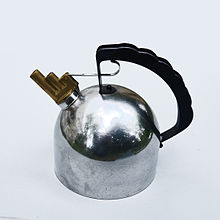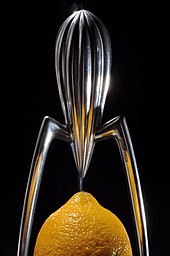Alessi (design)
Alessi is the name of Alberto Alessi's Italian design factory in Omegna , in the Crusinallo district ( Piedmont region ), which was founded in 1921 by his grandfather, Giovanni Alessi.
The production program ranges from styling products to re-editions of Bauhaus design classics . 2000 kitchen items are available; A bathroom program was introduced in 2002. The company employs 500 people and has an annual turnover of 108.5 million euros.
history
The company has its roots in the Italian countryside around Cusio . A number of metal goods manufacturers settled there as early as the 17th century . In 1920, Alessi took part in the Milan trade fair as one of the smaller companies. But the small family business soon became one of Italy's leading metalworking companies. In 1921 Giovanni Alessi bought a piece of land in this region and founded the Alessi company. It was a small craft company that specialized in metal housewares. Giovanni was an experienced metal lathe operator and it was very important that his objects were of quality . This careful execution soon made his products very popular. Initially, production was still made to order.
The 1920s and 1930s
Giovanni Alessi specialized in the manufacture of brass knobs in the early 1920s . The trademark were the intertwined initials "FAO", which stood for "Fratelli Alessi Omegna". The quality also developed positively thanks to new technologies, such as B. Nickel and silver plating. From 1924, "FAO" manufactured smaller household appliances as well as coffee pots and trays. At that time there was still a lack of material and the know-how of the production process to produce pots and cutlery.
Carlo Alessi, Giovanni's son, was a trained industrial designer and established design as we understand it today. He took over the company from his father. The objects that were created during this time, such as the “tea and coffee service” made of silver-plated alpaca from 1921, the “table bottle holder” made of nickel-plated brass from 1926 or the “cheese bowl” made of polished alpaca from 1929 are present in many Italian households. During the Second World War , when the products were no longer selling as well, Alessi had to think of something new and began to produce stars for uniforms and small parts for aircraft . When the war was over, they specialized in mass production. Ettore Alessi, Carlo Alessi's younger brother, eleven years younger, has worked in the company since 1945. Nowadays, however, Ettore no longer works in company management, but he is still considered a specialist in the technology of cold casting of metals.
The 1950s and 1960s
Alessi's symbol in the 1950s was a wire fruit basket designed in 1952. Carlo Alessi was the company's general manager during those years, but it was his brother Ettore Alessi who initiated collaboration with external designers in 1955. With some architects he designed a series of objects which were created for hotel use. Thanks to his help, many individual items were created that became bestsellers, such as the historical series of wire baskets. He also brought about a change in terms of materials, for example, he dropped brass and nickel silver and introduced stainless steel , which was actually introduced by Carlo at Alessi at the end of the 1930s .
This innovation brought some technical and structural changes.
Since 1956, a set has been produced in the style of the "Café pot 101" for restaurants, which is one of the most professional and best-selling items in Alessi history.
In 1957 the “Shaker”, the “Ice Bucket” and the “Ice Tongs” from “Program 4” were selected for the 11th Triennial in Milan as part of a debate for the development of industrial design. This was the first time that Alessi products were shown at an exhibition on industrial “author production”. Under the technical direction of Ettore Alessi, the winning run of the hotel supplies continued. In 1963 the handles and spouts of the “Dani” service were lengthened and more determined, creating a certain peculiarity that ranged from coffee pots to milk jugs.
The 1970s
In July 1970, Carlo Alessi's eldest son Alberto Alessi took over. He brought Michele, Alessio and Stefano Alessi into the company. With Franco Sargiani, the "Program 8" was developed, a range of housewares based on rectangular shapes. In 1979 Alessandro Mendini became the company's design consultant.
The turn of the millennium

In 2002 Stefano Giovannoni designed the "One" project in the bathing area, and Alessi published a watch collection. The architects Achille Castiglioni and Aldo Rossi were commissioned to design wristwatches as early as the 1980s - “Momento” by Rossi and “Record” by Castiglioni were created.
In 2003 the colorful children's tableware "Alessibambino" was published, which was then expanded with lamps and toys.
In 2005 two new collaborations were presented, the “Panda Alessi” car with Fiat and the “Alessi Textile” home textiles with the Belgian company Lyntex . In the same year there was a new edition of the "Program 8" series.
In 2006 the product range was divided into three brands, namely "Officina Alessi", "Alessi" and "A di Alessi":
- Officina Alessi
The exclusive brand for one-offs and limited series. The products have an experimental character in a higher price range.
- Alessi
This is about series production for the household.
- A di Alessi
The “dream factory” follows the original goal of creating high-quality products for a large audience that as many people as possible can afford.
Since April 2007 there has been a new bathroom collection, "ILBAGNOALESSI Dot". Here, too, Alessi worked with two other companies, with “Laufen” from Switzerland and “Oras” from Finland .
Well-known design objects from Alessi production are the kettles by Michael Graves (1985) and Richard Sapper (1983) and the lemon squeezer Juicy Salif by Philippe Starck (1990).
Designer
A selection of the designers and architects who work or have worked for Alessi:
- Carlo Alessi
- Philippe Starck
- Ettore Sottsass
- Richard Sapper
- Achille Castiglioni
- Alessandro Mendini
- Aldo Rossi
- Michael Graves
- Enzo Mari
- Stefano Giovannoni
- Guido Venturini
- Norman Foster
- Zaha Hadid
- Toyo Ito
- Marc Newson
- Jean Nouvel
- Greg Lynn
- Hans Hollein
- Patricia Urquiola
- Giulio Iacchetti
Quotes from the owner Alberto Alessi
- "Good design is forever."
- “Artists are like feathers in the air: you have to let them float. As soon as you cause a vortex, it's all over. "
literature
- Alberto Alessi: The dream factory - Alessi since 1921 . Könemann, Cologne 1998, ISBN 3-8290-1374-4 .
- Michael Collins: Alessi. Design Classic . Bassermann, Niedernhausen 1999, ISBN 3-8094-0780-1 .



